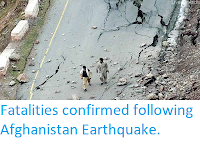Five miners have died and another one is missing following a collapse at a coal mine at Dahan-e-Tor, in the Dara-e-Soof District of Samagan Province, Afghanistan, on Tuesday 26 December 2017. Several other miners were injured in the event, which was reportedly caused by a methane explosion, which caused a section of tunnel to collapse. The mine is reported to have been an illegal (unlicensed) mine, one of many such mines operated local artisanal miners in the impoverished region.
The approximate location of the Dahan-e-Tor mine. Google Maps.
Coal is formed when buried organic material, principally wood, in heated
and pressurised, forcing off hydrogen and oxygen (i.e. water) and
leaving more-or-less pure carbon. Methane is formed by the decay of
organic material within the coal. There is typically little pore-space
within coal, but the methane can be trapped in a liquid form under
pressure. Some countries have started to extract this gas as a fuel in
its own right. When this pressure is released suddenly, as by mining
activity, then the methane turns back to a gas, expanding rapidly
causing, an explosion. This is a bit like the pressure being released on
a carbonated drink; the term 'explosion' does not necessarily imply
fire in this context, although as methane is flammable this is quite
likely.
Afghanistan has considerable reserves of coal, iron ore, copper and
other minerals, which it has hoped to use to attract foreign investment.
However frequent attacks on mining projects by militant groups opposed
to foreign involvement in the country has kept investors away, with
China pulling out of a US$3 billion copper mining project in Logar
Province in the east of the country in 2012. As a result safety standards at Afghan mines tend to be virtually
non-existent, with the nation lacking the money to invest in projects
that it runs, and many smaller artisanal mines being totally
unregulated, and often employing child labour.
See also...
Follow Sciency Thoughts on Facebook.







